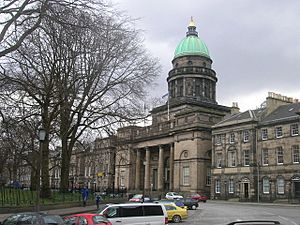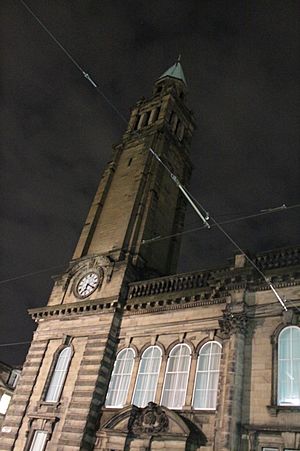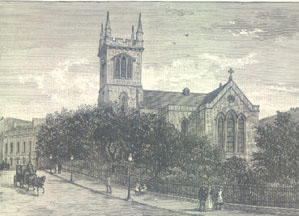Edinburgh: New Town Church facts for kids
Quick facts for kids Edinburgh: The New Town Church of Scotland |
|
|---|---|
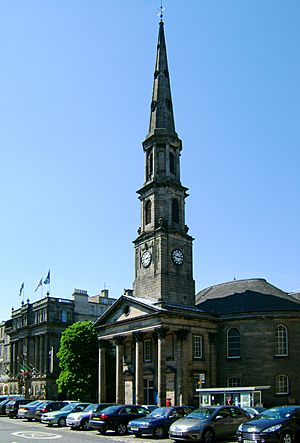 |
|
| 55°57′14.5″N 03°11′45″W / 55.954028°N 3.19583°W | |
| Location | 13 George Street, Edinburgh EH2 2PA |
| Country | Scotland |
| Denomination | Church of Scotland |
| Churchmanship | Reformed |
| Website | New Town Church |
| History | |
| Founded | 1781 |
| Dedication | Saint Andrew |
| Events | Disruption of 1843 |
| Architecture | |
| Heritage designation | Category A listed building |
| Designated | 13 January 1766 |
| Completed | 1784 |
| Administration | |
| Parish | Edinburgh New Town |
| Presbytery | Edinburgh |
The Edinburgh: The New Town Church of Scotland is a church in Edinburgh, Scotland. It serves the area known as the New Town. This church is part of the Church of Scotland. It was formed on February 1, 2024. This happened when two churches, St Andrew's & St George's West and Greenside Church, joined together.
The church building on George Street was finished in 1784. It is a very important historical building. Today, it is protected as a Category A listed building. This means it is a building of special architectural or historic interest.
Contents
Exploring the Church Buildings
When Edinburgh's New Town was planned, two main churches were designed. This was in 1767, during a time called the Scottish Enlightenment. Edinburgh was a hub for new ideas and thinking. The original plan was to build churches at each end of George Street. One was for Charlotte Square and the other for St Andrew Square.
However, a rich businessman named Sir Lawrence Dundas bought the land at St Andrew Square. He wanted to build his home there. So, St Andrew's Church had to be built a bit further along George Street. Dundas House, designed by William Chambers, was built in its place.
St Andrew's Church: A Unique Design
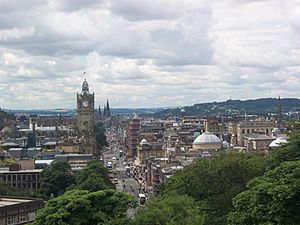
The Town Council held a contest to design St Andrew's Church. Captain Andrew Frazer and Robert Kay won. The church started being built in 1781 and opened in 1784. It was the first church in Britain with an oval shape inside. This shape worked well because the land was not very deep.
The church's style looks like old Roman buildings. It has a grand entrance with columns. The ceiling inside is also very detailed. It has designs similar to those found in ancient Roman homes. You can also spot Scottish thistles in the design. The pulpit, where the minister speaks, is on the north wall. There are wooden pews around the other sides.
The church originally had a short tower. But the Town Council decided to build a tall steeple instead. It was finished in 1787 and is 51 meters (about 167 feet) high. Inside the steeple are eight bells. They were made in 1788 and are the oldest complete set of bells in Scotland. They were fixed up in 2006 so they could be rung properly again. The church also has beautiful stained glass windows. Some show "The Beatitudes" and another shows "The Son of Man."
In 1976, the space under the church was turned into a useful area called the "Undercroft."
St George's Church: Now an Archive
St George's Church was built on the west side of Charlotte Square. Construction began in 1811. It opened in 1814. However, it had problems with its structure. Because of this, it closed in the 1960s. It was then taken over by the government. Today, it is used to store important historical documents. It is now part of the National Records of Scotland.
St George's West Church: A New Purpose
Free St George's Church was built between 1866 and 1869. It was designed by David Bryce. The church has a tall tower that looks like a famous bell tower in Venice, Italy.
In 1900, this church joined with others to form the United Free Church of Scotland. Later, in 1929, it became part of the Church of Scotland. It was then called St George's West. The building on Shandwick Place was later sold. It is now used by Charlotte Chapel, another church group.
Greenside Parish Church: A Local Landmark
Greenside Church became its own parish in 1836. It is located near Calton Hill. James Gillespie Graham designed the church in 1830. It took nine years to build and opened in 1839. In January 2024, Greenside Church joined with St Andrew's and St George's West Church. This union formed the new Edinburgh: The New Town Church of Scotland.
Church History: Key Moments
St Andrew's Church was the site of a very important event in Scottish history. This was the Disruption of 1843. Many ministers were unhappy with the government's influence on the Church of Scotland. About one-third of the ministers walked out of the church's annual meeting. They then formed a new church called the Free Church of Scotland.
In 1964, the St George's Church congregation joined with St Andrew's. This formed St Andrew's and St George's. The old St George's building is now used by the National Records of Scotland. The church also hosts a big annual book sale. This sale raises money for Christian Aid, a charity that helps people in need. In 2006, the sale raised over £113,000.
In January 2010, St Andrew's and St George's joined with St George's West. This created the St Andrew's and St George's West Church. Both buildings were used for a few years. The George Street building was the main place of worship.
In February 2013, St George's West church held its last service as a Church of Scotland building. The congregation moved back to the George Street church. The Shandwick Place building was sold to Charlotte Chapel. This is an independent Baptist church. They bought the building for £1.55 million.
Church Leaders
Many ministers have served the churches that now form Edinburgh: The New Town Church of Scotland. One notable minister was the Very Rev Dr Andrew McLellan. He was the leader of the General Assembly of the Church of Scotland in 2000. He also worked as the Chief Inspector of Prisons for Scotland.
Working Together: Edinburgh City Centre Churches
Edinburgh: The New Town Church of Scotland is part of a group called "Edinburgh City Centre Churches Together." This group includes three churches in Edinburgh's New Town. The other churches are St John's and St Cuthbert's. They work together on different projects.
Timeline of Church Unions
- 1784: St Andrew's Church opened.
- 1811: St George's Church opened.
- 1839: Greenside Church opened.
- 1843: The Disruption happened. This led to the formation of the Free Church of Scotland.
- 1869: St George's Free Church moved into its permanent building.
- 1929: St George's Free Church became St George's West Church.
- 1947: Queen Street Church and St Andrew's Church joined together.
- 1964: St George's Church closed as a place of worship and joined with St Andrew's Church.
- 1974: Hopetoun Church joined with Greenside Church.
- 1975: Abbey Church joined with Greenside Church.
- 2010: St Andrew's Church and St George's West Church joined. They formed St Andrew's and St George's West Church.
- 2013: The St George's West Church building was sold.
- 2024: Greenside Church joined with St Andrew's and St George's West Church. This formed the new New Town Church.
See also
- List of Church of Scotland parishes
- List of listed buildings in Edinburgh


